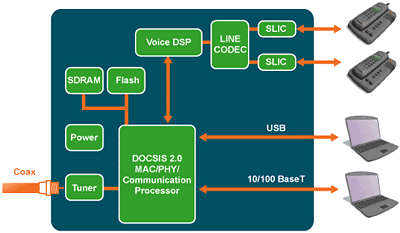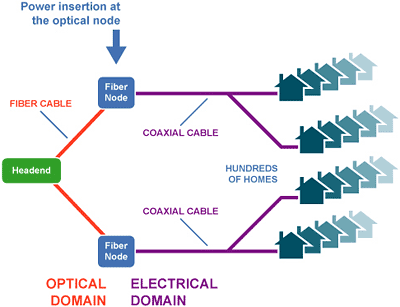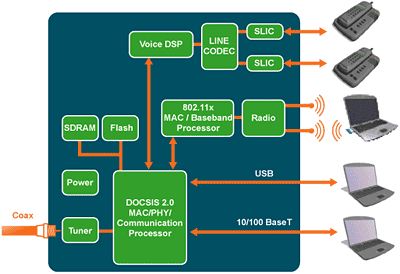Voice Up Your HFC Net
Voice-over-cable has received close media attention recently, and based on MSO comments, there’s no question that rollout has begun. As cable-based voice over Internet protocol (VoIP) trials turn into deployments, MSOs must decide which customer premises equipment (CPE) architecture to deploy. In an effort to accelerate customer acquisition, some MSOs have begun rolling out CPE that exists today. Others have selected a more conservative course, which includes careful analysis of the various CPE architectures and selection of the architecture that best meets the MSO and customer needs. EMTA architecture A voice-over-cable device, better known in cable as an embedded multimedia terminal adapter (E-MTA) is the sole piece of equipment needed at the customer premises to support delivery of both high-speed data and VoIP capabilities. The E-MTA integrates a Data Over Cable Service Interface Specification (DOCSIS) cable modem with voice processing capabilities. A typical E-MTA includes one or two RJ-11 telephone ports. The ports can be connected to one or two phones in close proximity, or they can be connected to any telephone jack in the home to provide connectivity to all of the standard telephone jacks throughout the house. The E-MTA also provides universal serial bus (USB) and Ethernet ports for data connectivity. As shown in Figure 1, the E-MTA hardware architecture consists of: From a software perspective, the DOCSIS 2.0 cable modem IC performs all of the processing for the DOCSIS management and packet handling/bridging, as well as all of the PacketCable or session initiation protocol (SIP) signaling, event logging and encryption. The voice DSP handles the voice-specific processing such as echo cancellation, voice activity detection, tone generation and detection, voice compression—through low-bit-rate (LBR) codecs—and fax relay. Backup options worldwide To ensure telephony services during the loss of power to the home, many MSOs have specified that E-MTAs deployed to their customer base include battery-backup technology. Battery backup is a key technological ingredient required by the MSO to market telephony service as a "true local exchange carrier (LEC) replacement" product. North America is leading the trend to deploy battery-backed E-MTAs. In contrast, many European service providers to date have focused on providing nonbattery-backed solutions. This could be due to the specific MSO’s business or technical requirements. A technical example could be the lack of backup powering on the network infrastructure. Throughout Asia the economic benefits of VoIP are the driving force behind service providers offering E-MTAs with public switched telephony network (PSTN) backup functionality. PSTN backup allows calls to be placed either via VoIP using the cable interface or as traditional calls over the PSTN. Typically, local calls are routed over the PSTN and long distance calls via the cable network using VoIP. This utilizes the cost advantages of VoIP. In addition, the PSTN interface can be used for all calls in the absence of a broadband network. Nonbattery backup As shown in Figure 1, the nonbattery backup architecture consists of a basic voice-enabled cable modem with a traditional wall socket power supply. If power is lost to the modem, then calls will not be able to be completed. From a CPE standpoint, nonbattery backed solution provides the most cost effective VoIP solution. Battery backup architecture The addition of a battery pack(s) and corresponding charging/monitoring circuitry and firmware are the only additions required to make an E-MTA battery-backed. The battery-backed E-MTA remains operational should a power "event"—loss of power, power spike, brownout, etc.—occur. Lithium Ion battery packs are the preferred battery technology as they have no charge/discharge memory effect and they provide a low self-discharge. Additionally, they possess up to five times the energy density of other solutions such as NiCad battery packs. This allows compact and lightweight E-MTA industrial designs. Design challenges Li-Ion battery packs require charge-controlling circuitry because their voltage is not constant over the useful range of their lives. The battery packs slowly wear out at an approximate rate of losing ~20% of capacity after 500 charge cycles. Finally, completely draining the batteries is not recommended, and many packs have protection against this occurring. These characteristics present challenging design constraints when using Li-Ion batteries, but they can be solved by employing good controlling circuits, firmware and industrial design practices. PSTN backup architecture The PSTN backup architecture allows calls to be made either over the PSTN as a standard call or over the cable network as VoIP call. Typically, local calls are routed over the PSTN and long distance calls via the cable network using VoIP. This provides a very economical way to make long distance calls while preserving exiting telephone operation. PSTN backup also ensures the subscriber will be able to make calls even in the event of a broadband service interruption. During normal operation, the subscriber’s telephone will be using PSTN+VoIP service by default. If the cable connection to the cable modem termination system (CMTS) is not available, the subscriber’s telephone will be automatically routed (inside the E-MTA) to use PSTN service for all calls instead. Outdoor E-MTAs The indoor E-MTA is a voice-enabled modem that sits somewhere in the home, typically in the basement or other "low foot-traffic" area. It has been widely adopted as the architecture of choice throughout the world to date due to service providers’ "adding-voice-to-a-data-subscriber" focus, as well as other reasons such as cost concerns. Some operators choose to provide an outdoor E-MTA solution to subscribers. Outdoor E-MTAs typically mount on an outside wall and interface to the house through the subscriber side of the existing network interface device (NID). Many traditional circuit switched cable voice deployments have used this approach. When it comes to voice-only service, an outdoor installation offers distinct advantages over indoor products as described below: Even with the previous advantages, however, there are a few key challenges involved in outdoor E-MTA deployments. Outdoor E-MTAs require: In the case of a hybrid fiber/coax (HFC) powered outdoor E-MTA, the logical point for power insertion is at the optical node. (See Figure 2). From here, coax can carry power to the customer premises. But this solution presents its own set of challenges. As power travels away from its insertion point, there is a voltage drop caused by loop resistance, and, at some point, voltage can become insufficient to drive devices on the network. At the same time, components such as taps and splitters can carry only a limited amount of power without suffering damage. The challenge is to provide power throughout the network without exceeding the upper limits of the network or dropping below the lower limits at any one point (1). As with any aspect of network design, the final power architecture depends upon economic, competitive, geographic and strategic factors. Future trends The evolution of the E-MTA architecture is beginning to unfold. Service providers are honing their business models and services in an effort to offer their customers a home networking alternative to that offered by digital subscriber line (DSL) providers. They are also geared to generate new revenues by offering advanced services. The integration of wireless local area network (WLAN) to the E-MTA has many potential benefits for home networking. The most compelling benefit is the E-MTA’s ability to provide voice-over-WLAN access-using both WLAN-enabled phones in the home and integrated cellular/WiFi handsets. Figure 3 shows the conceptual architecture of the WLAN-enabled EMTA. The beauty of a cable/cellular application is its ability to support cable and cellular subscribers with dual-mode cellular/WiFi handsets. When the subscriber is away from home, the handset would receive service from the traditional cellular network. When the subscriber is at home, the phone would switch over to the cable broadband IP network. The network, combined with an in-home WLAN protocol, would be used to transport signaling and media to the dual-mode handset (2). Some potential benefits for such an application could include residential tower offload for cellular carriers, cellular/landline feature integration for subscribers such as voice mail, dialing directories, find-me/follow-me, etc., and an enhanced service bundle for cable operators that would now include mobility services. The PacketCable-Cellular Integration Requirements Technical Report (2) provides a high-level reference framework that highlights the objectives and identifies the need to specify protocol enhancements/extensions to support this application. There also are many potential advanced service offerings that will be enabled by Wi-Fi enabled handsets. A "broadband-enabled" cell phone, with quality of service (QoS) provided by the PacketCable infrastructure, would enable high-quality audio and video streaming, full-speed Web browsing, instantaneous synchronizing with address books and email, and real-time Internet gaming. The previous examples and applications are only a partial list of next-generation services that have been conceived. There is no end to the number of services and device configurations that can be created based on voice-enabled broadband modems in the home. References Patrick Hibbs is a marketing manager in Texas Instruments’ Cable Broadband Communications group. Reach him at phibbs@ti.com Figure 1: Architecture of an EMTA  Figure 2: Coax power insertion choices for outdoor EMTAs
Figure 2: Coax power insertion choices for outdoor EMTAs  Figure 3: Architecture of a WLAN-enabled EMTA
Figure 3: Architecture of a WLAN-enabled EMTA  Bottom line Power Backup for IP Telephony As cable-based voice over Internet protocol (VoIP) trials are quickly turning into deployments, MSOs face an important question on which customer premise equipment (CPE) architecture they will deploy. A voice-over-cable device, better know in cable as an embedded multimedia terminal adapter (E-MTA) is the sole piece of equipment needed at the customer premises to support delivery of both high-speed data and VoIP capabilities. To ensure telephony services during the loss of power to the home, many MSOs have specified that E-MTAs deployed to their customer base include battery-backup technology. Battery backup is a key technological ingredient required by the MSO to market its telephony service as a "true local exchange carrier (LEC) replacement" product. This article reviews embedded voice-over-cable CPE backups that utilize nonbattery, battery and public switched telephone network (PSTN) solutions.
Bottom line Power Backup for IP Telephony As cable-based voice over Internet protocol (VoIP) trials are quickly turning into deployments, MSOs face an important question on which customer premise equipment (CPE) architecture they will deploy. A voice-over-cable device, better know in cable as an embedded multimedia terminal adapter (E-MTA) is the sole piece of equipment needed at the customer premises to support delivery of both high-speed data and VoIP capabilities. To ensure telephony services during the loss of power to the home, many MSOs have specified that E-MTAs deployed to their customer base include battery-backup technology. Battery backup is a key technological ingredient required by the MSO to market its telephony service as a "true local exchange carrier (LEC) replacement" product. This article reviews embedded voice-over-cable CPE backups that utilize nonbattery, battery and public switched telephone network (PSTN) solutions.